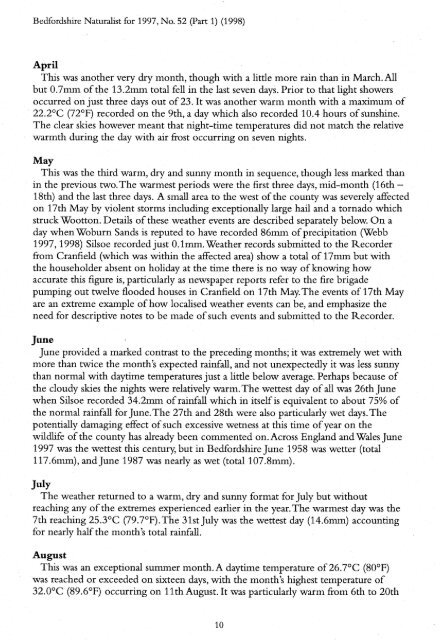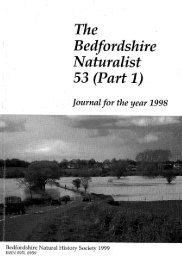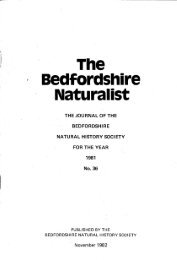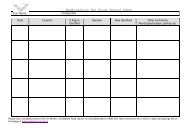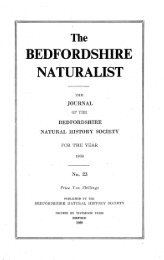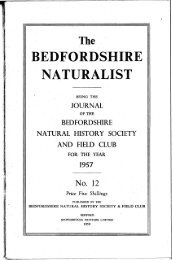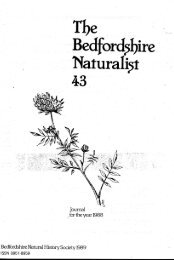1997 No. 52 Part 1 - Bedfordshire Natural History Society
1997 No. 52 Part 1 - Bedfordshire Natural History Society
1997 No. 52 Part 1 - Bedfordshire Natural History Society
Create successful ePaper yourself
Turn your PDF publications into a flip-book with our unique Google optimized e-Paper software.
<strong>Bedfordshire</strong> <strong>Natural</strong>ist for <strong>1997</strong>, <strong>No</strong>. <strong>52</strong> (<strong>Part</strong> 1) (1998)<br />
April<br />
This was another very dry month, though with a little more rain than in March. All<br />
but 0.7mm oftpe 13.2mm total fell in the last seven days. Prior to that light showers<br />
occurred on just three days out of23. It was another warm month with a maximum of<br />
22.2°C (72°F) recorded on the 9th, a day which also recorded 10.4 hours ofsunshine.<br />
The clear skies however meant that night-time temperatures did not match the relative<br />
warmth.during the day with air frost occurring on seven nights.<br />
May<br />
This was the third warm, dry and sunny month in sequence, though less marked than<br />
in the previous two. The warmest periods were the first three days, mid-month (16th <br />
18th) and the last three days. A small area to the west ofthe county was severely affected<br />
on 17th May by violent storms including exceptionally large hail and a tornado which<br />
struckWootton. Details ofthese weather events are· described separately belo~ On a<br />
day whenWoburn Sands is reputed to have recorded 86mm ofprecipitation (Webb<br />
<strong>1997</strong>, 1998) Silsoe recorded just O.lmm.Weather records submitted to the Recorder<br />
from Cranfield (which was within the affected area) show a total of 17mm but with<br />
the householder absent on holiday at the time there is no way ofknowing how<br />
accurate this figure is, particularly as newspaper reports refer to the fire brigade<br />
pumping out twelve flooded houses in Cranfield on 17th May. The events of 17th May<br />
are an extreme example ofhow localised weather events can be, and emphasize the<br />
need for descriptive notes to be made ofsuch events and submitted to the Recorder.<br />
June<br />
June provided a marked contrast to the preceding months; it was extremely wet with<br />
more than twice the month's expected rainfall, and not unexpectedly it was less sunny<br />
than normal with daytime temperatures just a little below average. Perhaps because of<br />
the cloudy skies the nights were relatively warm.The wettest day ofall was 26thJune<br />
whenSilsoe recorded 34.2mm ofrainfall which in itselfis equivalent to about 75% of<br />
the normal rainfall for June.The 27th and 28th were also particularly wet days. The<br />
potentially damaging effect ofsuch excessive wetness at this time ofyear on the<br />
wildlife ofthe Cfounty has already been commented on. Across England andWales June<br />
<strong>1997</strong> was the wettest this century, but in <strong>Bedfordshire</strong> June 1958 was wetter (total<br />
117.6mm), andJune 1987 was nearly as wet (total107.8mm).<br />
July<br />
The weather returned to a warm, dry and sunny format for July but without<br />
reaching any ofthe extremes experienced earlier in the year. The warmest day was the<br />
7th reaching 25.3°C (79.7°F).The 31st July was the wettest day (14.6mm) accounting<br />
for nearly· halfthe month's total rainfall.<br />
August<br />
This was an exceptional summer month. A daytime temperature·of26.7°C (80°F)<br />
was reached or exceeded on sixteen days, with the month's highest temperature of<br />
32.0°C (89.6°F) occurring on 11th August. It was particularly warm from 6th to 20th<br />
10


